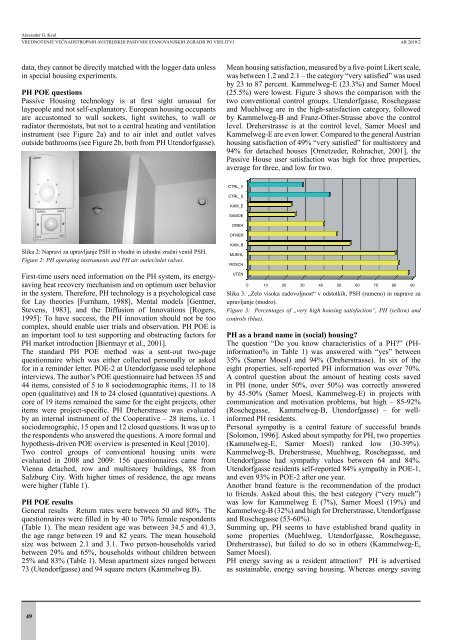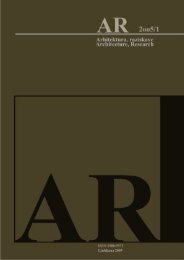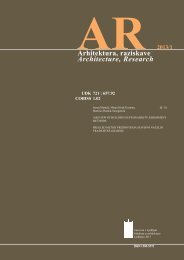AR 2010/2 - Fakulteta za arhitekturo
AR 2010/2 - Fakulteta za arhitekturo
AR 2010/2 - Fakulteta za arhitekturo
- No tags were found...
Create successful ePaper yourself
Turn your PDF publications into a flip-book with our unique Google optimized e-Paper software.
Alexander G. KeulVrednotenje večnadstropnih avstrijskih pasivnih stanovanjskih zgradb po vselitvi<strong>AR</strong> <strong>2010</strong>/2data, they cannot be directly matched with the logger data unlessin special housing experiments.PH POE questionsPassive Housing technology is at first sight unusual forlaypeople and not self-explanatory. European housing occupantsare accustomed to wall sockets, light switches, to wall orradiator thermostats, but not to a central heating and ventilationinstrument (see Figure 2a) and to air inlet and outlet valvesoutside bathrooms (see Figure 2b, both from PH Utendorfgasse).Mean housing satisfaction, measured by a five-point Likert scale,was between 1.2 and 2.1 – the category “very satisfied” was usedby 23 to 87 percent. Kammelweg-E (23.3%) and Samer Moesl(25.5%) were lowest. Figure 3 shows the comparison with thetwo conventional control groups. Utendorfgasse, Roschegasseand Muehlweg are in the high-satisfaction category, followedby Kammelweg-B and Franz-Ofner-Strasse above the controllevel. Dreherstrasse is at the control level, Samer Moesl andKammelweg-E are even lower. Compared to the general Austrianhousing satisfaction of 49% “very satisfied” for multistorey and94% for detached houses [Ornetzeder, Rohracher, 2001], thePassive House user satisfaction was high for three properties,average for three, and low for two.CTRL_VCTRL_SKAM_ESAMOEDREHOFNERSlika 2: Napravi <strong>za</strong> upravljanje PSH in vhodni in izhodni zračni ventil PSH.Figure 2: PH operating instruments and PH air outlet/inlet valves.First-time users need information on the PH system, its energysavingheat recovery mechanism and on optimum user behaviorin the system. Therefore, PH technology is a psychological casefor Lay theories [Furnham, 1988], Mental models [Gentner,Stevens, 1983], and the Diffusion of Innovations [Rogers,1995]: To have success, the PH innovation should not be toocomplex, should enable user trials and observation. PH POE isan important tool to test supporting and obstructing factors forPH market introduction [Biermayr et al., 2001].The standard PH POE method was a sent-out two-pagequestionnaire which was either collected personally or askedfor in a reminder letter. POE-2 at Utendorfgasse used telephoneinterviews. The author’s POE questionnaire had between 35 and44 items, consisted of 5 to 8 sociodemographic items, 11 to 18open (qualitative) and 18 to 24 closed (quantative) questions. Acore of 19 items remained the same for the eight projects, otheritems were project-specific. PH Dreherstrasse was evaluatedby an internal instrument of the Cooperative – 28 items, i.e. 1sociodemographic, 15 open and 12 closed questions. It was up tothe respondents who answered the questions. A more formal andhypothesis-driven POE overview is presented in Keul [<strong>2010</strong>].Two control groups of conventional housing units wereevaluated in 2008 and 2009: 156 questionnaires came fromVienna detached, row and multistorey buildings, 88 fromSalzburg City. With higher times of residence, the age meanswere higher (Table 1).PH POE resultsGeneral results Return rates were between 50 and 80%. Thequestionnaires were filled in by 40 to 70% female respondents(Table 1). The mean resident age was between 34.5 and 41.3,the age range between 19 and 82 years. The mean householdsize was between 2.1 and 3.1. Two person-households variedbetween 29% and 65%, households without children between25% and 83% (Table 1). Mean apartment sizes ranged between73 (Utendorfgasse) and 94 square meters (Kammelweg B).KAM_BMUEHLROSCHUTEN010 20 30 40 50 60 70 80 90Slika 3: „Zelo visoka <strong>za</strong>dovoljnost“ v odstotkih, PSH (rumeno) in naprave <strong>za</strong>upravljanje (modro).Figure 3: Percentages of „very high housing satisfaction“, PH (yellow) andcontrols (blue).PH as a brand name in (social) housing?The question “Do you know characteristics of a PH?” (PHinformation%in Table 1) was answered with “yes” between35% (Samer Moesl) and 94% (Dreherstrasse). In six of theeight properties, self-reported PH information was over 70%.A control question about the amount of heating costs savedin PH (none, under 50%, over 50%) was correctly answeredby 45-50% (Samer Moesl, Kammelweg-E) in projects withcommunication and motivation problems, but high – 85-92%(Roschegasse, Kammelweg-B, Utendorfgasse) – for wellinformedPH residents.Personal sympathy is a central feature of successful brands[Solomon, 1996]. Asked about sympathy for PH, two properties(Kammelweg-E, Samer Moesl) ranked low (30-39%).Kammelweg-B, Dreherstrasse, Muehlweg, Roschegasse, andUtendorfgasse had sympathy values between 64 and 84%.Utendorfgasse residents self-reported 84% sympathy in POE-1,and even 93% in POE-2 after one year.Another brand feature is the recommendation of the productto friends. Asked about this, the best category (“very much”)was low for Kammelweg E (7%), Samer Moesl (19%) andKammelweg-B (32%) and high for Dreherstrasse, Utendorfgasseand Roschegasse (53-60%).Summing up, PH seems to have established brand quality insome properties (Muehlweg, Utendorfgasse, Roschegasse,Dreherstrasse), but failed to do so in others (Kammelweg-E,Samer Moesl).PH energy saving as a resident attraction? PH is advertisedas sustainable, energy saving housing. Whereas energy saving49

















